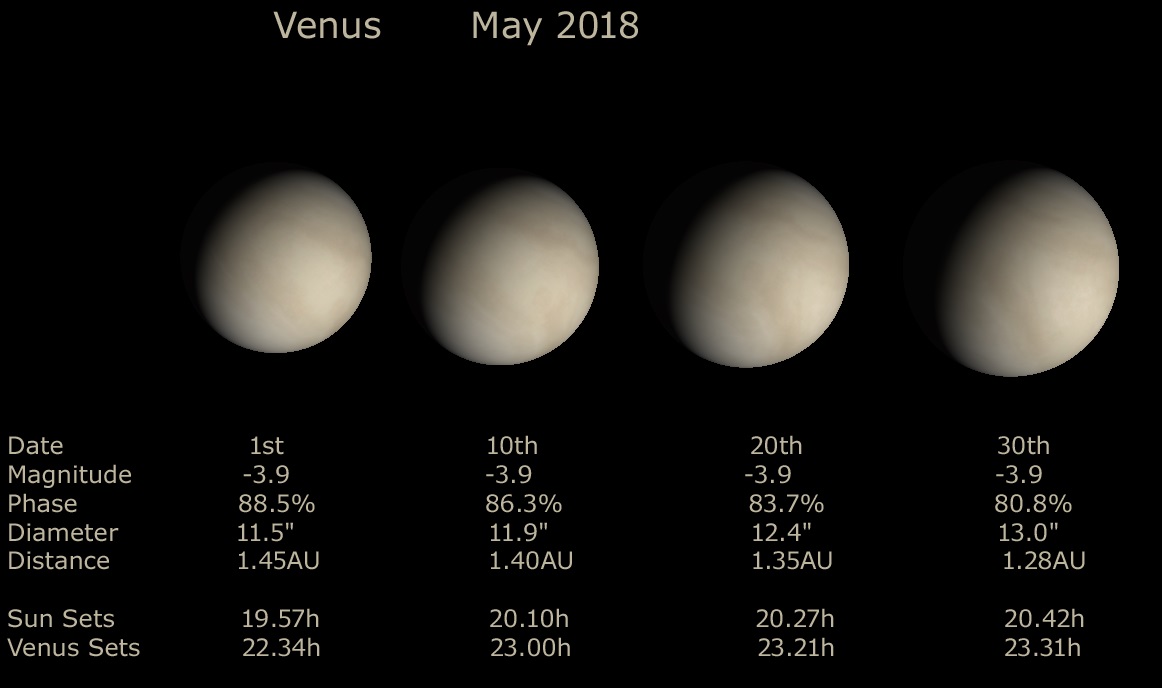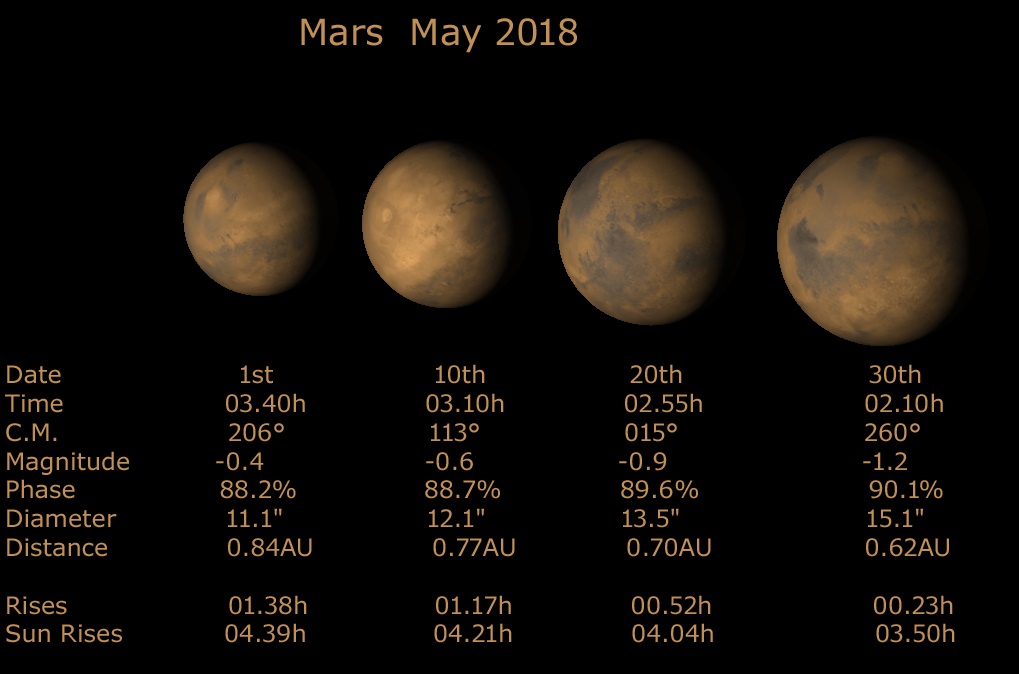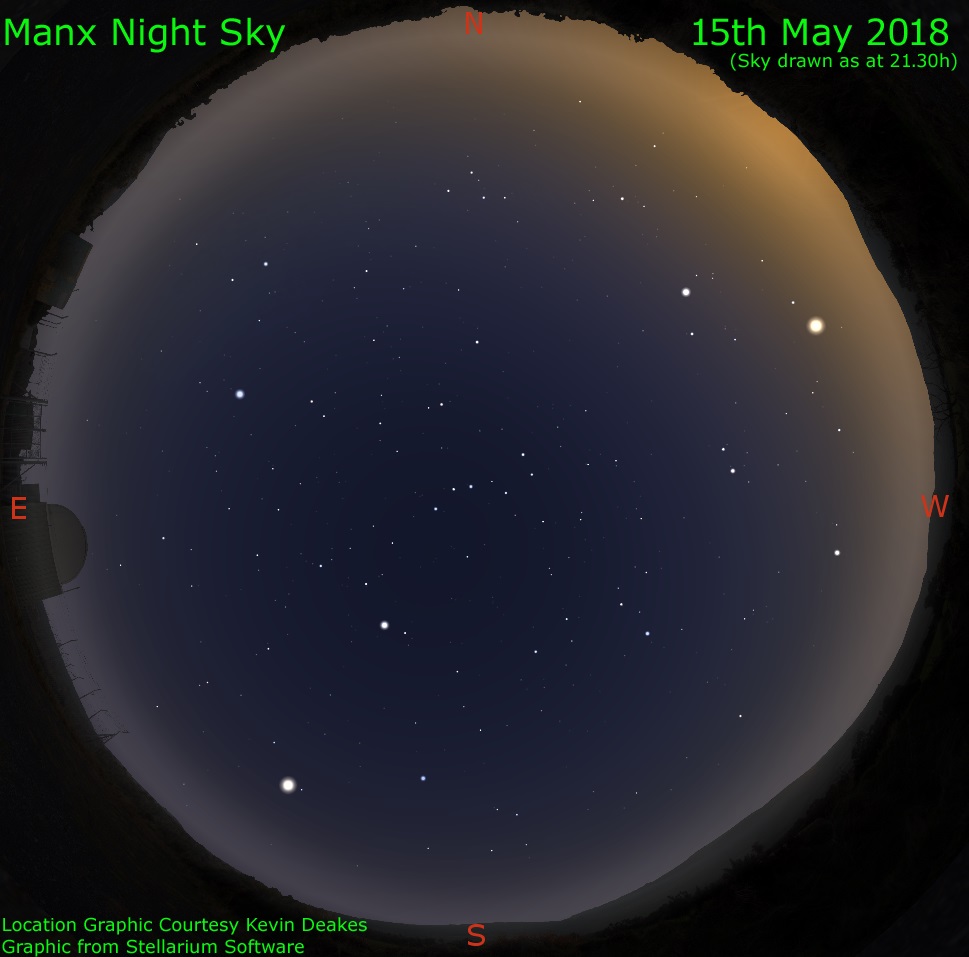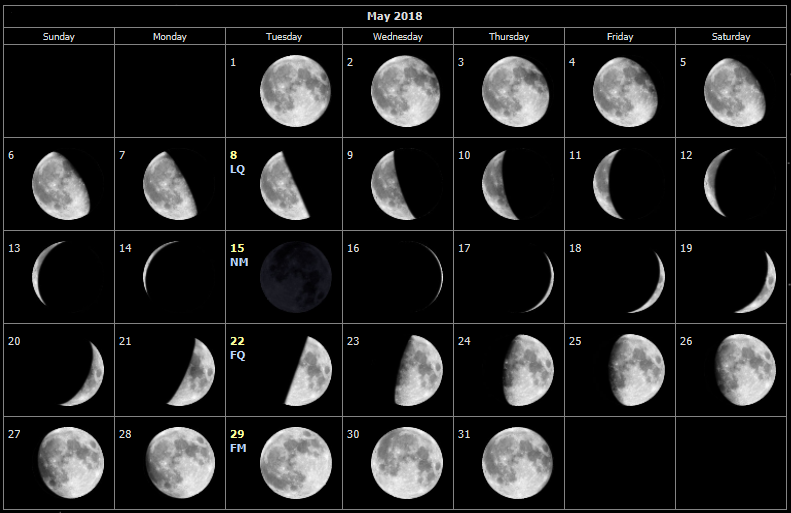In Manx skies... May 2018 ~ compiled by Dave Storey
New
15th
at
11.49h
First Quarter
22nd
at
03.50h
Full
29th
at
14.21h
Last Quarter
8th
at
02.10h
Note: All times are
Universal Time (UT)
British Summer Time
is now in force. Remember to add 1 hour to any times quoted here
to get local IoM time.
There are no Lunar or Solar eclipses this month.
Solar activity is low with solar cycle 24 now in force.
WARNING: NEVER DIRECTLY OBSERVE THE SUN WITH YOUR NAKED EYES AND/OR OPTICAL INSTRUMENTATION: YOU WILL BE BLINDED!
Carrington's Solar Rotation number 2204 starts on the 16th at 10h56m47s.
Is found in the morning skies just before sunrise. However, the planet is poorly placed for viewing from northern latitudes due to the shallow angle of the ecliptic plane with the horizon. The planet is best suited for southern hemisphere observers.

Will
be found shining very bright in the evening skies post sunset. It
will be at magnitude -3.9 during the month. As seen through a
telescope, the phase will be shrinking from 88.5% to 80.8%
illuminated, while the apparent disc diameter will be increasing
from 11.5” to 13.0”.
Venus
will be found 5.7° to the upper right of the thin (8%
illuminated) crescent Moon on the evening of the 17th.

Is
low in the south during the month rising at 01.38h on the 1st
and by 00.23h on the 31st . It will increase in
magnitude from -0.4 to -1.2 during the month as the planet draws
nearer to Earth. As seen through a telescope, the disc size will
grow from 11.1” to 15.1” . Due to the low altitude of
the planet from northern skies, the image seen will be degraded
somewhat as viewed in the telescope. Some surface details may
however be seen now the disc size has grown above 10 arc seconds.
The planet is better suited to southern hemisphere observers. The
waning gibbous Moon passes 2.5° north of Mars on the morning
of the 6th.

Is
at opposition on the 9th
in the constellation Libra,
shining at magnitude -2.5. On this date, Jupiter will be rising at
sunset and setting at sunrise, so is visible all night long. The
planet will be low down in the south, so will be affected by poor
atmospheric seeing when viewed in a telescope. The
near full Moon will be 3.7° upper left of Jupiter on the
morning of the 28th.
As the moons orbit Jupiter, there are occasions when the
shadow of the moons can be seen upon the surface of Jupiter and
the moons can transit across Jupiter's disc. Also, the moons can
be seen to be occulted or eclipsed by Jupiter. There are many
events throughout the month. See periodicals such as the BAA
Handbook, Astronomy Now
and Sky at Night
magazines for listings.
The Great Red Spot may be seen using a telescope in good seeing conditions. Using a light blue filter with an eyepiece will help. Opportunities to see the Great Red Spot from Mann occur on a regular basis. Click here. for suitable dates and times.
To help you identify the moons at any particular time, Sky and Telescope have a Java tool that will plot the moon positions. Click Here.
 Is
found low in the south in dawn skies. It resides in the
constellation Sagittarius shining at magnitude +0.3 to +0.2. Like
Jupiter and Mars, Saturn will be low down from our latitude and a
view through a telescope will be degraded due to poor seeing
conditions. The rings are well open towards the Earth at this time
and will look great through the telescope.
Is
found low in the south in dawn skies. It resides in the
constellation Sagittarius shining at magnitude +0.3 to +0.2. Like
Jupiter and Mars, Saturn will be low down from our latitude and a
view through a telescope will be degraded due to poor seeing
conditions. The rings are well open towards the Earth at this time
and will look great through the telescope.
The brightest moon of Saturn, Titan will be visible in telescopes, shining at magnitude +8.5 and will be east of the planet on 13th ,14th ,15th ,29th ,30th and 31st . It will be west of the planet on the 5th ,6th ,7th ,21st ,22nd and 23rd .
eta-Aquarids
are
active until the 20th with a maximum due on the 5-6 May. Zenithal
Hourly Rate ( ZHR
) is 40 meteors per hour. Radiant is at RA 22h30m Dec. -01°
These meteors originate from Halley's comet and enter the earth's
atmosphere at 42 miles per second.
Alpha-Scorpids
are
active until the 19th
May
with a peak activity occurring on the 12th.
ZHR
is low at on 5 meteors per hour. Radiant is at RA 16h04m Dec. -24°
Ophiuchids are active during May with maximum due in June. The shower is however weak.
Date Time ZC# SAO# Magnitude. P.A. Type of event. Notes
There are no suitable events this month.
For
very detailed list of occultations visible this month, click
here. (Data from Occult Software)
Times
are UT as seen from IoMAS Observatory. Start to observe these
events about 20 minutes before the above times to allow for
differences in your latitude and longitude. This will give you
time to locate the star that is about to be occulted.
ZC
= Zodiacal Catalogue. Type of Event DD = disappearance at dark
limb, RD = Reappearance at dark limb. RB = Reappearance on bright
limb. PA = Position Angle around limb of the Moon, where 0 degrees
is north, 90 degrees is east, 180 degrees is south and 270 degrees
is west.
D* = Double Star T* = Triple Star
The above predictions were calculated from Occult software by David Herald. More information regarding this software may be found at the lunar-occultations.com web site.
This star drops from magnitude +2.1 to +3.4 in about 5 hours. There are no suitable dates for observing this month. Click here for a star chart for Algol.
Comet
There are no predicted bright comets this month.
Noctilucent Clouds
Noctilucent Clouds may become visible towards the end of the month. These mysterious night time glowing clouds appear in the northern skies ans usually last between May to August. These clouds are very high at an altitude of around 90km. They are best seen around local midnight, looking due north. However, when a very active display is happening, they can be seen from sunset to sunrise.
The international Space Station crosses the Manx skies on a regular basis. For the latest information on when the ISS is due to pass across the sky over the next ten days, visit the link below.
Bibliography for Manx Night Skies
The
Handbook of the British Astronomical Association 2018. BAA.
2017
2018 Stargazing. Heather Couper & Nigel Henbest.
Philip's 2017
2018 Guide to the Night Sky. Storm Dunlop &
Wil Tirion. Collins 2017
Yearbook of Astronomy 2018. Brian
Jones/Richard Pearson. Pen & Sword White Owl. 2017
Observer's
Handbook Meteors. Neil Bone. Philip's 1993
Atlas of the Night
Sky. Storm Dunlop. Collins. 2005
Constellations. Josef Klepešta
and Antonin Rükl. Hamlyn. 1979
Brilliant Stars. Patrick
Moore. The Book People Ltd. 1996
Complete Guide to Stargazing.
Robin Scagell. Phillip's. 2006
Turn Left at Orion. Guy
Consolmango and Dan M. Davis. Cambridge U.P. 2008
Norton's
2000.0 Edited Ian Ridpath. Longman Scientific & Technical.
1989
Planetary data derived from
Guide 9
Software.
Picture graphics derived from Stellarium
and Guide 9 Software.

